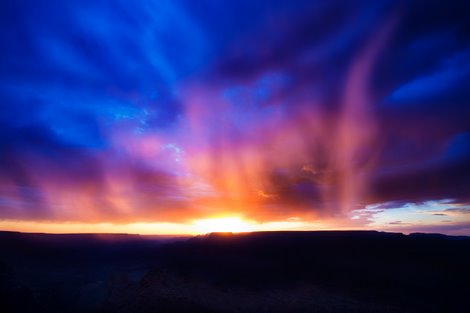Create Dramatic Images by Shooting for the Sky
When shooting outdoors, the sky is often part of the picture. Most of the time, though, it's a secondary (or tertiary) subject within the frame. What a shame.
The sky can be the extraordinary centerpiece of a photo — sometimes you just have to make it happen. Deep blues, white clouds, orange and red sunsets, stormy weather… and no two skies are the same. It's an ever changing landscape waiting to be captured in all it's glory. Here are a few tips for making the most of those skies.
MAKE IT THE MAIN SUBJECT
Sometimes the stuff in the sky is more interesting than the stuff on the ground. If this is the case, make the sky the main subject. Use the ground or overhanging trees to frame it and place it at the center of attention. Set your exposure for the sky and allow everything else to be darker — this will help to de-emphasize the other elements of the photo. Typically the sky gets blown out when shooting other subjects, so this method is a nice way to shake things up.
FILL THE FRAME WITH IT
There's no easier way to make the sky your main subject than to fill the frame with it. You'll want to leave something else in the photo to help ground it, so don't fill the entire frame with sky — more on this topic in a moment.
USE A WIDE ANGLE TO CAPTURE IT
One good way to fill the frame with sky is to use a wide angle lens. The wide angles help to add a large-scale feeling to things. With some wide angle lenses (such as my 10-20mm), you can actually capture well over 90 degrees of view. That means that you can grab a slice of ground while shooting directly overhead. The other thing I've noticed about wide angle shots of the sky is that the colors tend to be much more saturated and darker than at longer focal lengths. When I shoot at 10mm, the sky almost has the appearance you'd expect from a polarizing filter
USE A FILTER TO PUNCH IT UP
A polarizer is a great way to add some drama to the sky. They add contrast and can really richen the colors. I'm guilty of not having one, but it's on the top of my “to-buy” list. I've seen some really amazing “with and without” shots that show the true advantage to using a polarizer. For more information on polarizers, read Andrew Ferguson's guest article at the Photocritic titled “How a Polarizer Filter Works.”
USE THOSE ANCHORS
I alluded to this earlier, but when taking photos of the sky you have to remember to anchor your shot. Nothing but sky isn't very attractive because it's hard to tell exactly what we're looking at. An anchor can be anything other than sky that gives a sense of orientation and scale — it grounds the photo. Pay attention to what you use as an anchor, though, because it will often become the secondary subject in the frame.
HAVE FUN WITH IT
Shooting for the sky can be a fun photo shooting experiment, but don't forget to mix it up a bit. I only offer these tips as things to think about when you're out shooting something else. Because sometimes, we just forget to look up.
What other tips do you have for shooting the sky?




kRiZ cPEc
August 1, 2007Hey, I didn’t thought of using a wide angle for sky photos before. Thanks!
Trevor
August 1, 2007Good tips! Thanks for having practical information that I could go out and use right now.
Andrew Ferguson
August 1, 2007That image of the barn and the halo of clouds is still one of my favourite photos that you’ve taken.
“The other thing I’ve noticed about wide angle shots of the sky is that the colors tend to be much more saturated and darker than at longer focal lengths. When I shoot at 10mm, the sky almost has the appearance you’d expect from a polarizing filter”
I’ve noticed that too, but I haven’t been able to explain it either. I assume it’s something to do with the optics for wider lenses, but my handle on the uber-technical end of the photography is less of a handle and more of a detached piece of string.
My tip for sky photography? Shoot in the golden hours, but shoot a little later at sunset too. If you have a tripod, the sky turns a beautiful deep blue right after sunset.
Thanks for the link love, btw! I totally adore my polarizer; I’m going to head out and use it some more this evening.
Brian Auer
August 1, 2007I’ve noticed that deep blue phenomenon after the sun goes down — it makes for some really great shots. The shot at the top displayed the same thing, except it also had some fiery warm colors in there too.
The Dino
August 4, 2007I always liked interesting sky but I was not sure if it looks also good on picture. With this tips I might make it more interesting.
Brian Auer
August 6, 2007Hey, practice makes perfect!
James
June 1, 2008The sky is a great subject. I enjoy taking clouds during rain the most. There’s a specific strategy to it (to take the clouds without getting the rain in the lens.
Delellis
December 28, 2008This is so cool , especially the picture the mountain , I really like the light effects with the sun rays so visible shining down it makes everything appear so grandiose and eye caching.
And you are so right the sky’s ever changing cloud patterns and color makes it an excellent subject because it’s never the same every time you shoot it.